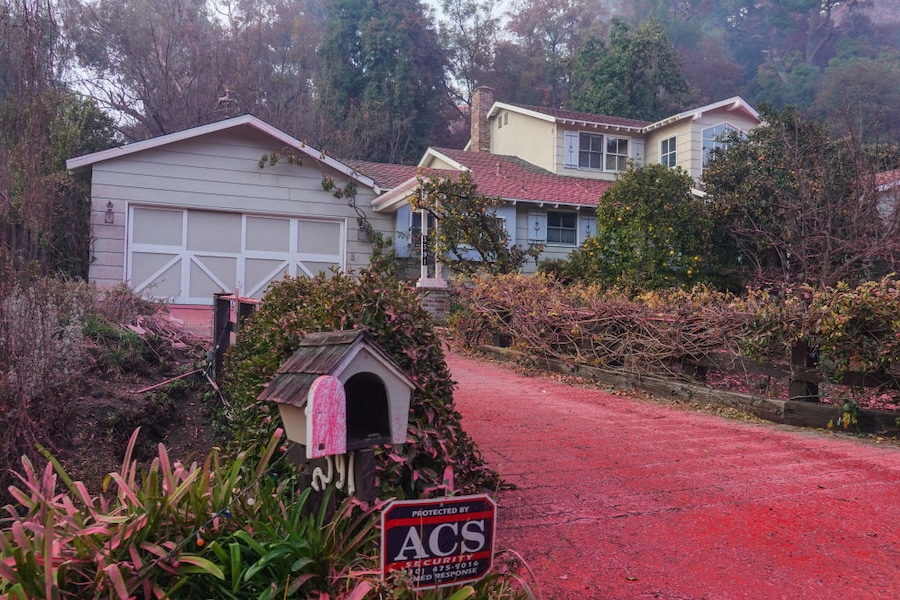This post was originally published on Eco Watch
Some wildfire suppressants in the U.S. contain levels of toxic metals up to 2,880 times the regulator limits set for drinking water, according to a recently published study. Further, researchers found that wildfire suppressants may have contributed to around 850,000 pounds of toxic metal pollution in the western U.S. from 2009 to 2021.
When toxic metal pollution shows up in the environment after wildfires, it has previously been estimated that the pollution could be linked to human activities like mining in nearby urban areas or from ash deposition.
The US federal government and chemical makers have long concealed the contents of pink wildfire suppressants – the substances are rife with cadmium, arsenic, chromium and other toxic heavy metals.
— Guardian US (@us.theguardian.com) February 13, 2025 at 3:14 PM
But two different sources led researchers from the Department of Civil and Environmental Engineering at the University of Southern California to investigate potential toxic metals in wildfire suppressants. According to the study, the Washington Department of Ecology issued multiple citations to a USFS air tanker base in 2016 for exceeding the amount of metal concentrations allowed in waste discharge. The researchers also found an internal document for tanker bases from the U.S. Bureau of Land Management (BLM) that explained that a particular retardant contains ammonia, cadmium and chromium.
The study authors also credit LAist reporter Jacob Margolis, who had reached out to corresponding author Daniel McCurry back in 2019 to inquire about potential contamination by fire suppressants.
According to the authors, any wildfire suppressants, which include fire retardants, water enhancers and foams, have to be approved by the U.S. Forest Service (USFS) before use. But the manufacturers can retain up to 20% of formulations as trade secrets or proprietary information, while products for public use do not need to disclose any percentage of their formulations.
In response to these findings and inquiries, the researchers purchased fire suppressant products and used mass spectrometry to quantify the amounts of vanadium, chromium, manganese, copper, arsenic, cadmium, antimony, barium, thallium and lead in the products and compared the amounts they found with data on suppressant application rates to calculate about how many heavy metals have been released by these products in the western U.S. over a 10-year timeframe.
In total, they found that at least eight heavy metals in the fires suppressants were at concentrations higher than the maximum level for drinking water set by the U.S. Environmental Protection Agency. The authors published their research in the journal Environmental Science and Technology Letters.
They also found that one particular product, Phos-Chek LC-95 W, had the greatest amounts of most of the heavy metals tested, although this specific product is not used by Cal Fire, LAist reported.
“I think what surprised me most was the array of metals we found,” lead author Marella Schammel said in a statement. “Some of them make sense as they’re used as corrosion inhibitors (chromium and cadmium) or are known contaminants in phosphate ores (arsenic, among others) used in the active ingredient of the retardant. But others, like vanadium — which there’s a ton of in Phos-Chek — were definitely unexpected.”
Based on their research, the authors estimated that from 2009 to 2021, about 380,000 kilograms or 1 million pounds of heavy metals had been dropped into the environment in the western U.S.
However, USFS and Cal Fire noted that they do work to avoid dropping any fire suppressants near waterways during wildfires to minimize environmental impact.
“We recognize that fire retardant is generally safe in the quantities that are applied to any given area. For sensitive areas like waterways and endangered species habitat, we restrict the use of fire retardant,” Linnea Edmeier, public information officer with Cal Fire, told LAist. “While Cal Fire prioritizes safety and environmental protection, we also recognize the critical role of fire retardants in firefighting.”
With the recent fires in Los Angeles, the authors raised concerns over the amounts of fire suppressant used in residential areas.
“Are the hazardous waste thresholds the appropriate bar for these to clear, or, if they’re being used in a massive scale in populated neighborhoods, do we need to get stricter on permissible concentrations of toxic compounds?” McCurry said, as reported by The Guardian.
McCurry also said that to fully differentiate between the potential sources of toxic metal contamination in the environment, studies would need to investigate the levels of contamination before and after a wildfire.
“As rates of aerial fire retardant application have grown, likely so too have loadings of toxic metals released into the environment from their use, a trend which may intensify if wildfire frequency and intensity continues to increase,” the authors concluded. “Further work should determine the environmental fate of metals released by aerial fire suppression (i.e., determine whether they remain in the soil column, permeate into groundwater, or enter nearby surface waters via runoff), and estimate the extent to which they contribute to human and ecological health risk.”
The post U.S. Wildfire Suppressants Revealed as Major Sources of Toxic Metal Pollution appeared first on EcoWatch.





0 Comments